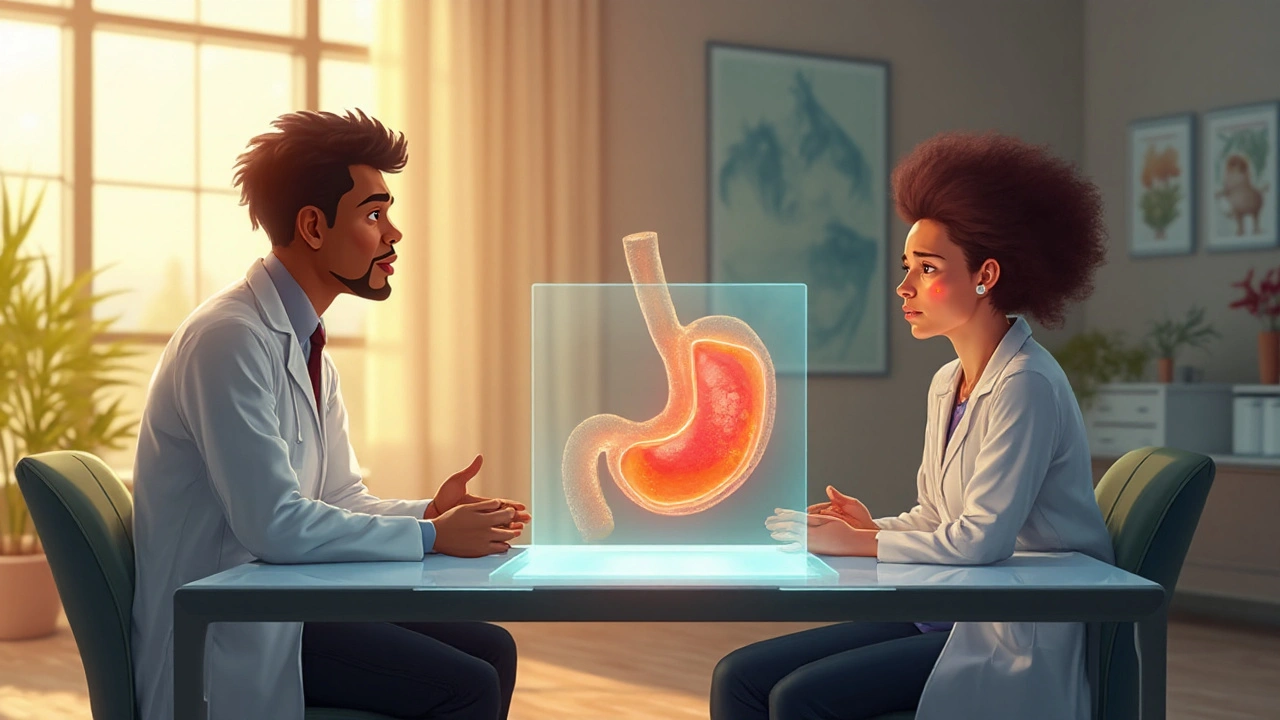Ulcer is a break in the stomach or duodenal lining that creates a sore, often caused by excess acid, Helicobacter pylori infection, or NSAID use. In contrast, Gastritis is inflammation of the stomach lining, which may be acute or chronic and is frequently linked to the same irritants but without a full‑thickness break. While both conditions share triggers, they differ in depth, symptoms, and long‑term risk. Understanding these nuances helps you spot warning signs early and choose the right treatment.
What Drives Each Condition?
Both ulcers and gastritis can arise from a handful of common culprits, yet the way each culprit interacts with the stomach wall varies.
- Helicobacter pylori is a spiral‑shaped bacterium that colonises the mucus layer. It releases urease, neutralising acid locally and allowing deeper penetration, which is a principal driver of peptic ulcer disease.
- NSAIDs (e.g., ibuprofen, aspirin) inhibit prostaglandin synthesis, weakening the protective mucus barrier and reducing blood flow to the gastric mucosa. This can lead to both inflammation and erosion.
- Excessive alcohol, smoking, and chronic stress increase acid production, aggravating the mucosal lining.
- Autoimmune attacks on the parietal cells diminish stomach acid, paradoxically fostering chronic gastritis.
Depth and Damage: How They Differ
Ulcers are full‑thickness defects that extend through the mucosa into the submucosa, sometimes reaching the muscular layer. Gastritis, however, stays within the mucosal layer, causing swelling, redness, and sometimes erosions that don’t breach deeper tissues. This distinction matters because ulcers carry a higher risk of bleeding, perforation, and even cancer if left untreated.
Symptoms: Spot the Tell‑Tale Signs
Because the triggers overlap, symptoms can feel similar, but subtle clues point to one or the other:
| Feature | Ulcer | Gastritis |
|---|---|---|
| Pain Location | Burning in upper abdomen, often after meals | Generalised stomach ache, may improve with food |
| Timing | Night‑time or 2‑3hours post‑eating | Immediate after eating or during stress |
| Bleeding | Occasional black stools or vomiting blood | Rare, usually mild irritation |
| Weight Change | Weight loss due to pain‑avoidance eating | Weight loss only if chronic |
How Doctors Diagnose Them
Diagnosis starts with a detailed history and physical exam, but confirming the condition often requires imaging or endoscopic tools.
- Endoscopy allows direct visualisation of the gastric lining, identifying ulcers (visible crater) or gastritis (red, inflamed mucosa). Biopsies taken during the procedure can test for H. pylori or malignant cells.
- Non‑invasive tests include urea breath tests, stool antigen tests, and serology for H. pylori.
- Blood tests may reveal anemia from chronic bleeding, especially in ulcer patients.

Treatment Strategies: Tailoring to the Condition
While lifestyle tweaks overlap, medication regimens differ based on depth and cause.
Ulcer Management
- Triple‑therapy eradication: a proton pump inhibitor (PPI) (e.g., omeprazole) + two antibiotics (clarithromycin and amoxicillin) for 14days.
- High‑dose PPIs alone can promote healing if H. pylori is absent.
- Stop NSAIDs; switch to acetaminophen or COX‑2‑selective agents.
- In refractory cases, endoscopic clipping or surgery may be needed.
Gastritis Management
- If H. pylori‑positive, apply the same triple‑therapy regimen. \n
- PPIs or H2‑blockers reduce acid and allow mucosal recovery.
- Antacids provide quick relief for acute flare‑ups.
- Dietary adjustments: avoid spicy, acidic, and fatty foods; limit alcohol and caffeine.
- For autoimmune gastritis, vitamin B12 supplementation is essential.
Prevention: Keeping the Stomach Happy
Simple, evidence‑backed habits can lower the odds of both conditions:
- Eat regular, balanced meals; don’t skip breakfast.
- Limit NSAID use; discuss alternatives with your GP.
- Quit smoking - it impairs mucosal blood flow and raises acid output.
- Moderate alcohol consumption; heavy drinking damages the mucus barrier.
- Test and treat H. pylori if you have a history of ulcers or chronic gastritis.
Related Topics You Might Explore Next
Understanding the ulcer‑gastritis spectrum opens doors to other stomach‑health subjects. Consider reading about:
- Peptic ulcer disease complications (bleeding, perforation)
- Gut microbiome’s role in mucosal inflammation
- Probiotic therapy for H. pylori eradication support
- Long‑term PPI safety and alternatives
Frequently Asked Questions
Can gastritis turn into an ulcer?
Yes. Persistent inflammation can erode the mucosal barrier, allowing acid to damage deeper layers and eventually form an ulcer. Prompt treatment of chronic gastritis reduces this risk.
Is an ulcer always caused by H. pylori?
No. While H. pylori accounts for about 60‑70% of cases, NSAID use, excessive acid, and rare genetic disorders also cause ulcers. Testing is essential to pinpoint the cause.
Do I need an endoscopy for every stomach pain?
Not always. Doctors reserve endoscopy for red‑flag symptoms like vomiting blood, unexplained weight loss, or persistent pain beyond a few weeks. Non‑invasive tests often suffice for initial assessment.
Can I take antacids while on PPI therapy?
Yes, but space them out by at least two hours. Antacids work quickly, while PPIs need time to suppress acid production. Combining them can give immediate relief plus long‑term healing.
What lifestyle changes matter most?
Cutting NSAIDs, quitting smoking, moderating alcohol, and eating balanced meals have the biggest impact. Stress management helps, but it’s the physical irritants that most directly damage the lining.

Calandra Harris
September 25, 2025 AT 03:26Ulcers are the real enemy of a strong nation’s health.
Dan Burbank
September 25, 2025 AT 06:13Reading this, one cannot help but notice the glaring omission of the socioeconomic factors that drive both ulcer and gastritis prevalence. It is as if the author prefers to dwell on biochemical pathways while ignoring the lived realities of patients. The dramatics of “burning night‑time pain” sound more like a theatrical script than a clinical nuance. Still, the breakdown of H. pylori’s role deserves a nod.
Anna Marie
September 25, 2025 AT 09:00Thank you for the thorough overview; the distinctions you've drawn are truly valuable for anyone navigating these conditions. It’s especially helpful to see the practical lifestyle adjustments side by side with pharmacologic options. Your clear layout will make it easier for readers to discuss next steps with their physicians.
Abdulraheem yahya
September 25, 2025 AT 11:46When I first encountered the terms ulcer and gastritis in a community health workshop, the differences seemed academic, but lived experience tells another story. An ulcer, by definition, creates a full‑thickness breach, which means the body’s protective barriers are literally punctured, exposing delicate vasculature to harsh gastric acid. This exposure can precipitate bleeding that manifests as melena or even hematemesis, scenarios that demand urgent medical attention. In contrast, gastritis inflames the mucosal layer without necessarily tearing through it; the pain is often more diffuse, and patients may find temporary relief after a meal, a paradox that confounds many clinicians.
From a pathophysiological perspective, both conditions share H. pylori as a common adversary, yet the bacterium’s mechanisms diverge. In ulcer disease, the organism’s urease activity creates a localized alkaline pocket, allowing it to infiltrate deeper tissues. Gastritis, however, often results from chronic irritant exposure-think NSAIDs, alcohol, or autoimmune attack-leading to a sustained inflammatory milieu rather than a focal breach.
The clinical management reflects these nuances. For ulcers, the gold standard remains triple‑therapy eradication combined with high‑dose proton pump inhibitors to promote mucosal healing. Gastritis may respond to similar regimens if H. pylori is present, but the cornerstone is acid suppression via PPIs or H2 blockers and eliminating the offending irritant, such as discontinuing NSAIDs.
Beyond medication, lifestyle modification holds equal weight. Regular, balanced meals, smoking cessation, and moderated alcohol intake create a hospitable environment for the gastric lining to recover. For those battling autoimmune gastritis, vigilant monitoring of vitamin B12 levels is indispensable, as intrinsic factor deficiency can precipitate pernicious anemia.
In my own community outreach, I’ve seen patients who, after adopting these comprehensive strategies, transition from chronic discomfort to a state of remission. Their stories underscore that while pharmacotherapy initiates healing, sustained behavioral change cements it. The interplay of medical and lifestyle interventions is where true recovery resides.
Finally, prevention cannot be overstated. Routine screening for H. pylori, judicious NSAID use, and early intervention at the first sign of dyspepsia can halt the progression from gastritis to ulceration. Knowledge empowers patients to act before irreversible damage occurs.
Preeti Sharma
September 25, 2025 AT 14:33One could argue that labeling ulcers as “worse” oversimplifies a spectrum where chronic gastritis might silently progress to malignancy if left unchecked. The philosophical lesson here is that health, like ethics, resists binary categorization.
Ted G
September 25, 2025 AT 17:20Did you know the government hides the true cure for H. pylori? The mainstream meds are just a distraction.
Miriam Bresticker
September 25, 2025 AT 20:06Great info! 👍👍👍
Claire Willett
September 25, 2025 AT 22:53Evidence‑based protocol: PPIs → H. pylori test → eradication regimen. Adhere to prevent complications.
olivia guerrero
September 26, 2025 AT 01:40Wow, such a comprehensive guide, and I love how it breaks down each step, making it so easy to follow, especially for newcomers!
Dominique Jacobs
September 26, 2025 AT 04:26Take charge of your gut health now-no more excuses, just action!
Claire Kondash
September 26, 2025 AT 07:13📚 The interplay between acid secretion, mucosal defense, and microbial colonization reads like a cosmic dance, each step influencing the next. When the balance tips, pathology emerges, reminding us that the body is a fragile ecosystem.
Matt Tait
September 26, 2025 AT 10:00Honestly, the article could have cut the fluff and gotten to the point faster.
Benton Myers
September 26, 2025 AT 12:46Clear and concise, good read.
Pat Mills
September 26, 2025 AT 15:33From a patriotic perspective, safeguarding the health of our citizens is a matter of national security; ulcers, being the more invasive pathology, demand immediate attention to preserve the workforce. Meanwhile, gastritis, though uncomfortable, does not pose the same immediate threat to our productive capacity. Therefore, policy should prioritize ulcer screening programs in high‑risk populations, such as veterans and first responders, to maintain our nation’s strength.
neethu Sreenivas
September 26, 2025 AT 18:20🔍 I appreciate the thoroughness here-especially the emphasis on B12 monitoring for autoimmune gastritis. That detail often slips through the cracks! 🌟
Keli Richards
September 26, 2025 AT 21:06Thanks for the clear breakdown its really helpful
Ravikumar Padala
September 26, 2025 AT 23:53While the article is informative, it seems to ignore the socioeconomic disparities that affect access to endoscopic diagnostics. In many low‑resource settings, patients rely on clinical judgment alone, which can lead to misdiagnosis. Addressing this gap is crucial for equitable care.
King Shayne I
September 27, 2025 AT 02:40Good points, but remember to double‑check medication interactions.
jennifer jackson
September 27, 2025 AT 05:26Stay positive, your gut will thank you!
Brenda Martinez
September 27, 2025 AT 08:13Let’s be real-if you’re still not on a PPI after all this, you’re basically inviting disaster. The data is crystal clear: untreated ulcers can lead to bleeding, perforation, even mortality. Stop procrastinating and get proper treatment now.